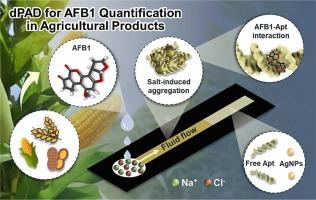Distance-Based Paper Microfluidic Analytical Device Using Aptamer Functionalized Silver Nanomaterial for Aflatoxin B1 Quantification in Food Products
IF 3.7
1区 化学
Q1 CHEMISTRY, ANALYTICAL
引用次数: 0
Abstract
In this article, a simple and affordable distance-based paper analytical device (dPAD) for the quantitative detection of aflatoxin B1 (AFB1) in agricultural food products has been successfully developed. The sensing assay is based on the salt-induced aggregation of silver nanoparticles (AgNPs), which exhibit a localized surface plasmon resonance (LSPR) response. This aggregation is triggered by the specific binding between AFB1 and aptamers pre-deposited on the detection zone of the sensor. When AFB1 binds to the aptamer, the released AgNPs interact with salt flowing through the channel, leading to nanoparticle aggregation and a visible colour change from yellow to orange-brown. The concentration of AFB1 can then be easily determined by measuring the length of the resulting colour band along the channel. The sensor provided a linear range between 0.3 and 0.8 ng mL-1 (R2 = 0.9986) with a detection limit (LOD) of 0.05 ng mL-1, with the fast reaction time of 8 min. It also exhibits excellent detection selectivity, with no significant interference from other compounds. The method demonstrates excellent accuracy and precision for AFB1 monitoring in food products, including corn, wheat, and peanut, with recovery ranging from 95.0% to 105.0% with the highest relative standard deviation (RSD) of 4.8%. By integrating microfluidics, nanomaterials, and aptamers, this technique shows great promise for the sensitive and selective detection of AFB1. Moreover, it represents a significant step forward in developing low-cost analytical platforms for a wide range of target molecules, making it highly applicable for real-world applications.

应用适配体功能化银纳米材料的远距离纸微流控分析装置定量测定食品中黄曲霉毒素B1
本文成功研制了一种简便、经济的农业食品中黄曲霉毒素B1 (AFB1)定量检测的远程纸张分析装置(dPAD)。传感试验是基于盐诱导的银纳米粒子(AgNPs)聚集,其表现出局部表面等离子体共振(LSPR)响应。这种聚集是由AFB1和预先沉积在传感器检测区的适体之间的特异性结合触发的。当AFB1与适配体结合时,释放的AgNPs与流经通道的盐相互作用,导致纳米颗粒聚集,并可见颜色从黄色变为橙棕色。然后,通过测量沿通道产生的色带的长度,可以很容易地确定AFB1的浓度。该传感器的线性范围为0.3 ~ 0.8 ng mL-1 (R2 = 0.9986),检出限(LOD)为0.05 ng mL-1,快速反应时间为8 min。它还具有良好的检测选择性,不受其他化合物的明显干扰。该方法对玉米、小麦、花生等食品中AFB1的检测具有良好的准确度和精密度,回收率为95.0% ~ 105.0%,最高相对标准偏差(RSD)为4.8%。通过整合微流体、纳米材料和适体,该技术对AFB1的敏感和选择性检测显示出很大的希望。此外,它代表了为广泛的目标分子开发低成本分析平台的重要一步,使其高度适用于现实世界的应用。
本文章由计算机程序翻译,如有差异,请以英文原文为准。
求助全文
约1分钟内获得全文
求助全文
来源期刊

Sensors and Actuators B: Chemical
工程技术-电化学
CiteScore
14.60
自引率
11.90%
发文量
1776
审稿时长
3.2 months
期刊介绍:
Sensors & Actuators, B: Chemical is an international journal focused on the research and development of chemical transducers. It covers chemical sensors and biosensors, chemical actuators, and analytical microsystems. The journal is interdisciplinary, aiming to publish original works showcasing substantial advancements beyond the current state of the art in these fields, with practical applicability to solving meaningful analytical problems. Review articles are accepted by invitation from an Editor of the journal.
 求助内容:
求助内容: 应助结果提醒方式:
应助结果提醒方式:


